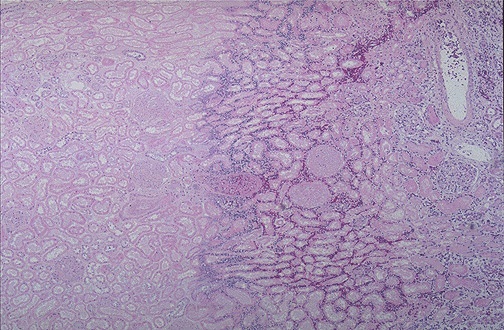
Kidney: Infarct

1.
What pathological process does it illustrate?
Ischemic
coagulative necrosis
2.
Describe
the configuration of lesion and explain why it is so?
They
are wedge shaped, with the base against the cortical surface and the apex
pointing towards the medulla.
There may be a narrow rim of preserved subcortical tissue that has been
spared by the collateral capsular circulation.
3.
Name
the structures affected by the process.
Nephrons
4.
Name
2 possible causes.
Global hypoperfusion due to cardiac failure.
Renal artery stenosis leading to reduced blood flowing to kidneys.
5.
Is
the process reversible?
No.
6.
What
is the final outcome of this lesion?
Fibrous
scarring giving rise to depressed, pale, grey-white scar that assume V shape on
section
7.
What
is the status of the other kidney?
Normal
8.
True
/ False MCQs. Clinical features in this condition includes:
Fever
� true if there is infections
Back
pain �
true
Haematuria
� true
Leucopenia
- false
Dysuria
- false
Casts
in urine - true
Protein
in urine - true
Decrease
in urine output - true
Leg
oedema - true
Always
symptomatic � false
<< PREVIOUS INDEX NEXT SLIDE >>
Copyright � Joseph Ong 2003